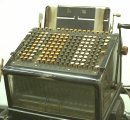
Worksheets and No Prep Teaching Resources
Reading Comprehension Worksheets
Inventors and Inventions

Inventors and Inventions
 Worksheets and No Prep Teaching Resources Reading Comprehension Worksheets Inventors and Inventions |
 Inventors and Inventions |
| edHelper's suggested reading level: | grades 7 to 8 | |
| Flesch-Kincaid grade level: | 7.45 |
|
William Seward Burroughs
By Sharon Fabian |

|
 1 At one time or another, most everyone has thought, "Wouldn't it be nice if there was a machine to do this boring work for me." Students imagine machines that would do their homework or pick up the stuff on their bedroom floor. Parents wish for a machine that would clean the house or cook dinners. Workers wish for a machine that would do the most tedious parts of their jobs for them.
1 At one time or another, most everyone has thought, "Wouldn't it be nice if there was a machine to do this boring work for me." Students imagine machines that would do their homework or pick up the stuff on their bedroom floor. Parents wish for a machine that would clean the house or cook dinners. Workers wish for a machine that would do the most tedious parts of their jobs for them. |
Create Weekly Reading Books
Prepare for an entire week at once! |
| Leave your feedback on William Seward Burroughs (use this link if you found an error in the story) |
 |
Inventors and Inventions
|
 |
Social Studies
|